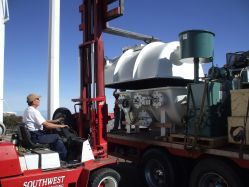Sophisticated Spectrometer Moving from Arizona to ODU
February 02, 2012
 Components of the FTS are loaded onto a truckbed in Arizona for the move to Virginia.
Components of the FTS are loaded onto a truckbed in Arizona for the move to Virginia.
One of the world's most colorful solar instruments is moving cross country for a new life dissecting the chemistry of comets, planets and stars. Its new home will be Old Dominion University, where it will be used under the direction of Peter Bernath, chair of the Department of Chemistry and Biochemistry.
The Fourier Transform Spectrometer (FTS) recently ended its career with the National Solar Observatory (NSO) at Kitt Peak, Ariz. After weeks of dismantling and packing, it began its move on Wednesday, with arrival in Norfolk scheduled for Thursday, Feb. 9.
Bernath, a longtime user of the FTS while it was at Kitt Peak, negotiated the gift of the instrument to ODU. Aided by the FTS, Bernath and colleagues were the first to discover traces of steam inside sunspots ("Water on the Sun") which to the layman seems unlikely given the 5,000 degrees F temperature of the sunspots.
"The FTS is one of the premier instruments for laboratory spectroscopy, high-resolution solar spectroscopy and other research," Bernath said. "It is a fantastic instrument."
The FTS was built in 1971-76 and used almost continuously through 2001 at NSO's McMath-Pierce Solar Telescope at Kitt Peak for solar and atmospheric physics, and as a stand-alone laboratory spectrometer. It has been used only sparingly in the past decade. Pressures on the NSO budget have made it impossible to keep operating the FTS, and other operators at Kitt Peak have expressed interest in its lab space.
James Brault, a physicist who joined NSO in the mid-1960s, designed the instrument. He had a strong aptitude for instrumentation and computer programming, and applied his unique perspective and talents to what was then considered a radical departure from spectrograph design.
Millions of people have seen one of the FTS's products, a reconstruction of the Sun's spectrum mottled with black absorption lines representing the fingerprints of atoms in the solar atmosphere (from "Solar Flux Atlas from 296 to 1300 nm"). The colorful image only hints at the power of the FTS, which can measure the intensity of light in incredibly narrow slices of the spectrum from 250 nanometers (ultraviolet) to 18,000 nanometers (18 microns; far infrared). Human vision spans just 380-770 nm (violet to deep red).
"I would like to use the FTS in a laboratory here at ODU to make measurements related to molecules in the atmospheres of planets, comets and stars, as well as for undergraduate and graduate teaching," Bernath said. For example, Bernath has used the FTS to analyze an unusual cousin of cyanide, CN molecules (cyano free radical) found in many astronomical sources and in flames here on Earth. His particular interest is molecules made of rare carbon-13 or nitrogen-15 isotopes, or both. The slight mass difference causes subtle changes in emissions from the more common version, shedding light on the composition, history and origin of comets, planets and stars.
The heart of the FTS goes back to 1887 and early relativity experiments involving the speed of light by A.A. Michelson. Mechanical yardsticks wouldn't do, so Michelson used light. Folding a beam of light back on itself forms light and dark patterns as the light waves interfere with each other. Changes along the path alter the pattern in a measurable fashion. This allows measuring the intensity of light at extremely fine fractions of a wavelength.
Such precision required special carriages that slide the FTS's optics on fine oil bearings mounted atop a polished granite table, all inside a vacuum chamber as a laser measures their ever-changing positions. The Fourier Transform part of the name refers to a sophisticated type of math used to reconstruct the spectrum from the interference pattern. Its delicate system gave the FTS exquisite precision that made it invaluable in the history of solar physics, and should make it an asset for continued exploration of the cosmos.
NSO's mission is to advance knowledge of the Sun, both as an astronomical object and as the dominant external influence on Earth, by providing forefront observational opportunities to the research community. NSO is operated by the Association of Universities for Research in Astronomy (AURA Inc.) under a cooperative agreement with the National Science Foundation for the benefit of the astronomical community.
Bernath is an internationally known research investigator and scholar whose work in molecular spectroscopy and chemical physics has helped us know more about greenhouse gases and molecules of astrophysical importance. He joined Old Dominion in the fall of 2011 as the chemistry and biochemistry chair.
He came to ODU from the University of York in England, where he was chair of physical chemistry and director of the York Center of Laser Spectroscopy.
A Fellow of the Optical Society of America, Bernath was the lead scientist for the Atmospheric Chemistry Experiment (ACE), a Canadian satellite mission that began in 2003 and has turned up important information about climate change and air quality. He took on that project while he was professor of chemistry (with a cross appointment in physics) at the University of Waterloo in Canada.
Bernath received the 2009 Alouette Award of the Canadian Aeronautics and Space Institute and the 2004 Excellence in Research Award from the University of Waterloo largely on the strength of his innovations and accomplishments in satellite remote sensing of pollution.

